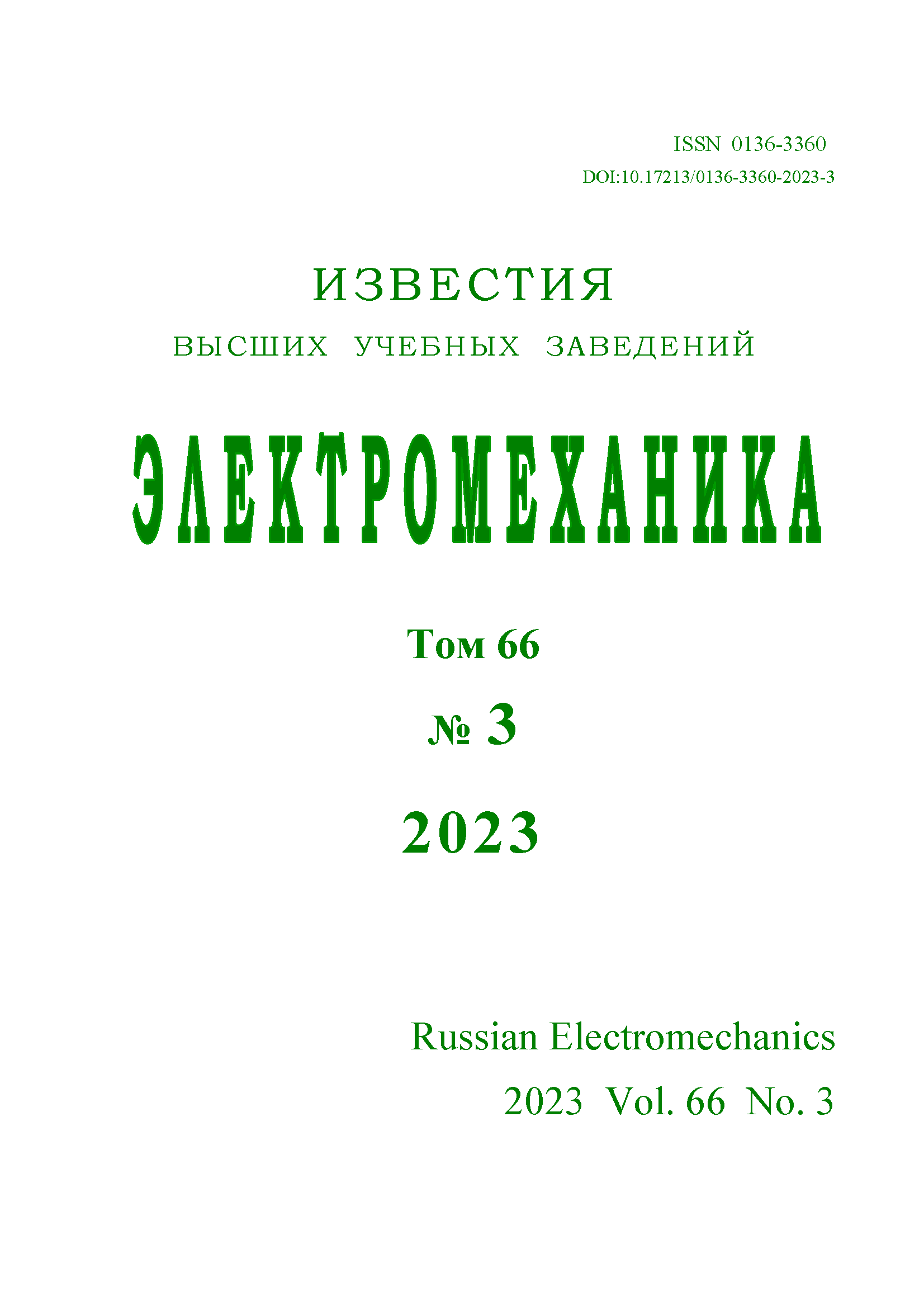Studying a magnetic regulation feasibility of mechanical characteristic of the induction magnetoelectric brake
DOI:
https://doi.org/10.17213/0136-3360-2023-3-22-28Keywords:
permanent magnet, induction magnetoelectric brake, magnetic regulation, mechanical characteristicAbstract
Introduction. Induction magnetoelectric brakes and clutches are widely used in a number of areas. The use of permanent magnets (PM) to create an excitation field can significantly reduce energy costs. In some cases it is necessary to control the braking torque. The paper describes and investigates the design of an induction brake, which provides the possibility of magnetic control of the braking torque by changing the configuration of magnetic circuit.
Methods and results. To evaluate the braking torque, it is necessary to determine the primary and secondary magnetic fields. The secondary field is determined by the analytical method, and the calculation of the primary field of the PM is carried out by the finite element method.
Conclusion. Analysis of modeling and calculation results showed that the regulation depth of the electromagnetic torque with the proposed method can reach from 100 to 4%.
References
Linear Eddy Current Brake for Railway Vehicles Using Dynamic Braking / Y. Sakamoto, T. Kashiwagi, T. Sasakawa,
N. Fujii // Proc. 2008 Int. Conf. Electr. Mach. ICEM’08. 2008. Pр. 1 – 6. DOI: 10.1109/ICELMACH.2008.4800088.
Ebrahimi B., Khamesee M.B., Golnaraghi F. Eddy Current Damper Feasibility in Automobile Suspension: Modeling, Simula-tion and Testing // Smart Mater. Struct. 2009. Vol. 18, № 1. Pр. 1 – 12. DOI 10.1088/0964-1726/18/1/015017
Mini Review on the Design of Axial Type Eddy Current Braking Technology / Waloyo H. T., Ubaidillah U.,
Tjahjana D.D.D.P., Nizam M., Koga T. // International Journal of Power Electronics and Drive Systems, 2019. Vol. 10, № 4.
Pр. 2198 – 2205. DOI: 10.11591/ijpeds.v10.i4. Pp. 2198-2205
Sattarov R.R. Electromechanical Transients in Passive Suspension Systems With Eddy Current Dampers // 2016 9th Interna-tional Conference on Power Drives Systems, ICPDS 2016 - Conference Proceedings. Perm, 2016. Pр. 1 – 6. DOI 10.1109/ICPDS.2016.7756676.
Lequesne B. Eddy-current Machines with Permanent Magnets and Solid Rotors // IEEE Trans. Ind. Appl. 1997. Vol. 33,
№ 5. Pр. 1289 – 1294. DOI: 10.1109/28.633808
Analytical Model for a Permanent Magnet Eddy-Current Brake with Transverse Edge Effect / Y. Jin, B. Kou, L. Li, C. Li, D. Pan and K. Song // IEEE Access. IEEE, 2019. Vol. 7. Pр. 61170-61179. DOI: 10.1109/ACCESS.2019.2915973.
Потапов Л.А., Бабак С.Ю. Моделирование явнополюсного тормоза с полым немагнитным ротором // Электротехни-ка. 2011. № 5. С. 30 – 34.
Analysis and Design of Hybrid Excitation Linear Eddy current brake / B. Kou, Y. Jin, H. Zhang, L. Zhang and H. Zhang // IEEE Trans. ENERGY Convers. 2014. Vol. 29, № 2. Pр. 496 –506. DOI: 10.1109/TEC.2014.2307164.
Sattarov R.R. 2D Model of Axial-Flux Eddy Current Brakes with Slotted Conductive Disk Rotor // 2017 International Siberi-an Conference on Control and Communications, SIBCON 2017 - Proceedings, Astana, 29 – 30 июня 2017 года. Astana, 2017.
Pр. 7998501. DOI: 10.1109/SIBCON.2017.7998501.
Sattarov R.R. The Controllable Eddy Current Brakes with Permanent Magnets: Basic Concept // 2018 10th International Conference on Electrical Power Drive Systems, ICEPDS 2018. Novocherkassk, 2018. Pр. 8571742. DOI: 10.1109/ICEPDS.2018.8571742.
Sattarov R.R., Garafutdinov D.R. Simulation of a Self-Regulating Eddy-Current Brakes with Permanent Magnets // 2021 In-ternational Ural Conference on Electrical Power Engineering (UralCon), Magnitogorsk, Russian Federation, 2021, Pp. 587 – 591, DOI: 10.1109/UralCon52005.2021.9559615.
Tessarolo A., Mezzarobba M., Menis R. Modeling, Analysis, and Testing of a Novel Spoke-Type Interior Permanent Mag-net Motor with Improved Flux Weakening Capability // IEEE Trans. Magn. 2015. Vol. 51, № 4. DOI: 10.1109/TMAG.2014.2357225
Barbini N., Bortolozzi M., Tessarolo A. Performance Evaluation of a Vehicle Traction Drive Based on a Permanent Magnet Synchronous Motor Equipped with a Mechanical Flux Weakening Device // 2016 Eleventh International Conference on Ecological Ve-hicles and Renewable Energies (EVER). IEEE, 2016. Pр. 1 – 6. DOI: 10.1109/EVER.2016.7476372
Татевосян А. А., Мищенко В. С. Моделирование магнитного поля синхронного генератора с постоянными магнита-ми // Омский научный вестник. 2016. №. 4 (148). С. 90 – 93.
Потапов Л.А., Максимцев Е.И. Полевой подход к расчету электромеханических устройств с немагнитными ротора-ми // Электротехника. 2000. № 8. С. 8 – 10.
Потапов Л.А. Математические модели электромеханических устройств с полыми немагнитными роторами для уста-новившихся и переходных режимов работы // Изв. вузов. Электромеханика. 1987. № 4. С. 24 – 34.
Саттаров Р.Р., Исмагилов Ф. Р. Метод расчета электромагнитных демпферов с распределенной вторичной системой сложной геометрии // Электричество. 2010. № 5. С. 37 – 43.
Математическое моделирование токов во вторичном элементе линейного асинхронного двигателя с продольным магнитным потоком для высокоскоростного транспорта / В.А. Соломин, А.В. Соломин, П.Г. Колпахчьян, Н.А. Трубицина // Изв. вузов. Электромеханика. 2014. № 4. С. 40 – 44.







